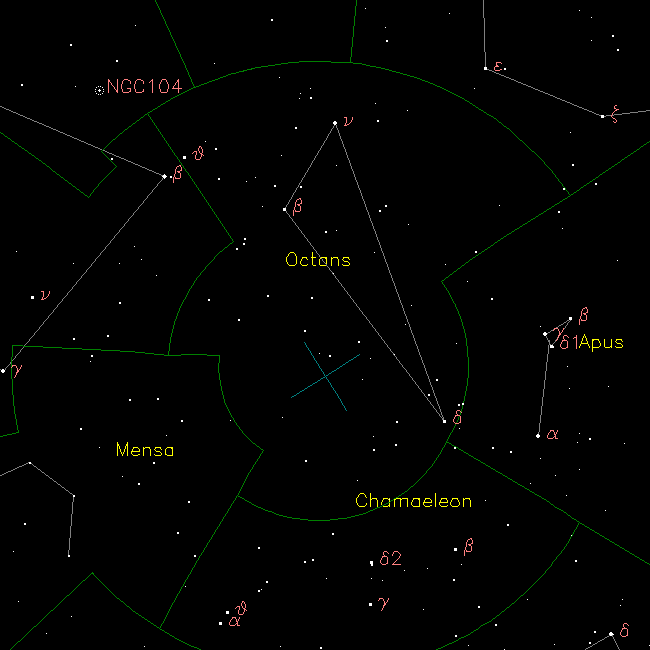[/caption]
The small constellation southern circumpolar constellation of Norma was originally charted by Abbe Nicolas Louis de Lacaille who named it. It was later adopted by the IAU as one of the modern 88 constellations. Octans contains the south celestial pole and spans 297 square degrees of sky – ranking 50th in size. It has 3 primary stars in its asterism and 27 Bayer Flamsteed designated stars within its confines. Octans is bordered by the constellations of Tucana, Indus, Pavo, Apus, Chamaeleon, Mensa and Hydrus. It is visible to observers located at latitudes between +0° and ?90° and its primary stars are best seen at culmination during the month of October.
Since Octans is considered a “new” constellation, there is no mythology associated with it – only Abbe Nicolas Louis de Lacaille’s love of all things science and what Octans is meant to represent. In Lacaille’s time, the octant was used to aid in celestial navigation and it was relatively a new addition, having just come upon the scene when invented by John Hadley in 1730. It was a tool which Lacaille used, but Octans also has other scientific means, which Lacaille was well aware. In Latin, the octan is the eighth part of a circle, so its dual-edged meaning is not lost on some of us! Just as the octant was used to measure Polaris position in the circumpolar north – now the octant became “Octans” – a permanent reminder of the tool forever engraved in the circumpolar stars of the south.
Let’s begin our binocular tour of Octans with Beta – the “B” symbol on our map. At one time, Beta Octantis was another star in located in the constellation of Hydrus. It was part of the tail and was the southernmost star catalogued by Dutch navigator Frederic de Houtman. Located about 140 light years from Earth, this yellow- orange class K (K0) giant star isn’t anything special – except for it helps to point the way to Nu. Located only 69 light years away from our solar system, Nu Octantis is a wonderful star because here we have an example of what our own Sun may one day become. Right now, it has given up on hydrogen fusion, waiting quietly and just beginning to expand into a giant star. Although it will take 100 million years, it will become more than 60 times brighter and 15 times larger than it is now. Although we can’t see it, Nu also has a companion star – one that orbits almost as close as Earth is to the Sun!
Now, have a look at Delta – the figure “8” shape – in your binoculars. Guess what? If you were standing on Saturn, Delta would be the pole star! But, since we’re not, we’ll take a look at Sigma – the “o” symbol. This faint beauty is about as close to the southern pole star as we can get. Sigma Octantis is a yellow subgiant star which just left the main sequence and is about to expand into a red giant star. It’s about twice as large as our Sun and about 270 light years away.
For a nice binocular site, take a look at visual triple star – the Gammas. It’s the “Y” symbol on our map. Or try a visual double star when you get a double slice of Pi, located just above Delta. That only leaves poor R Octantis – a variable star.
For a real big telescope challenge, try the closest NGC object to the southern pole – NGC 2573 (RA 04:41:42 Dec -89:20:04). Polarissima Australis is a faint galaxy – close to magnitude 14! Believe it or not, it was discovered by was discovered by Sir John Herschel at the Cape of Good Hope with an 18″ f/13 speculum telescope and has been the recent target of investigations looking for gamma ray bursters.
Sources:
Wikipedia
University of Illinois
University of Wisconsin
Star Chart courtesy of Your Sky.

